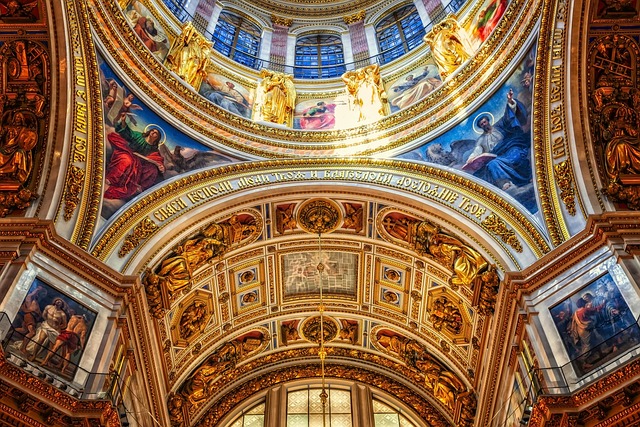Orthodox Christianity, also known as Eastern Orthodox Church, is one of the three major branches of Christianity, alongside Roman Catholicism and Protestantism. It encompasses a diverse group of self-governing churches that share common beliefs and practices. Orthodox believers adhere to a set of core theological doctrines, liturgical traditions, and spiritual practices that have been passed down through generations. This introduction provides a brief overview of what Orthodox Christians believe.
Table of Contents
The Divinity of Jesus Christ in Orthodox Christianity
What Orthodox Believe: The Divinity of Jesus Christ in Orthodox Christianity
Orthodox Christianity, with its rich history and deep-rooted traditions, holds a firm belief in the divinity of Jesus Christ. For Orthodox believers, Jesus is not just a prophet or a wise teacher, but the Son of God, fully divine and fully human. This fundamental belief is at the core of Orthodox theology and shapes the way Orthodox Christians understand and worship Jesus.
To understand the Orthodox belief in the divinity of Jesus Christ, it is essential to delve into the concept of the Incarnation. According to Orthodox teaching, Jesus is the Incarnate Word of God, the Second Person of the Holy Trinity. In the mystery of the Incarnation, the eternal Son of God took on human flesh and became fully human while retaining His divine nature. This union of divinity and humanity in the person of Jesus Christ is a central tenet of Orthodox faith.
The Orthodox Church teaches that Jesus Christ is consubstantial with the Father, meaning that He shares the same essence and nature as God the Father. This belief is rooted in the Nicene Creed, which was formulated in the fourth century to combat heresies that denied the divinity of Christ. The Creed affirms that Jesus is “begotten, not made, of one essence with the Father.” This declaration underscores the Orthodox understanding of Jesus as fully divine, equal to the Father in essence.
Orthodox Christians also believe that Jesus Christ is the perfect image and likeness of God. In the Gospel of John, Jesus Himself declares, “Whoever has seen me has seen the Father” (John 14:9). This statement emphasizes the unity between Jesus and God the Father, highlighting Jesus’ divine nature. Orthodox believers see in Jesus the full revelation of God’s love, mercy, and wisdom, making Him the ultimate source of salvation and the way to eternal life.
The divinity of Jesus Christ is not merely an abstract theological concept for Orthodox Christians. It has profound implications for their spiritual life and worship. In the Orthodox tradition, icons play a significant role in connecting believers with the divine. Icons are not seen as mere paintings but as windows into the heavenly realm. They depict Christ as the Pantocrator, the ruler of all, radiating divine light and majesty. Through icons, Orthodox Christians encounter the living presence of the divine, experiencing a tangible connection with Jesus Christ.
Furthermore, the Orthodox liturgy, with its rich symbolism and ancient prayers, reflects the belief in the divinity of Jesus Christ. In the Divine Liturgy, the Eucharist is celebrated as the true body and blood of Christ. Orthodox Christians partake in the Holy Communion, believing that they are receiving the very essence of Christ into their lives. This sacramental encounter with the divine strengthens their faith and deepens their relationship with Jesus.
In conclusion, the divinity of Jesus Christ is a central belief in Orthodox Christianity. Orthodox believers affirm that Jesus is not just a human teacher or prophet but the Son of God, fully divine and fully human. This belief in the Incarnation, the consubstantiality with the Father, and the perfect image of God shapes the way Orthodox Christians understand and worship Jesus. Icons and the liturgy play a vital role in connecting believers with the divine, allowing them to experience the living presence of Jesus Christ. For Orthodox Christians, the divinity of Jesus is not just a theological concept but a lived reality that transforms their lives and brings them closer to God.
The Role of Icons in Orthodox Worship and Spirituality

Icons play a significant role in Orthodox worship and spirituality. These religious images are not mere decorations but are considered windows to the divine. They are believed to be a means of connecting with the spiritual realm and are venerated as sacred objects.
In Orthodox Christianity, icons are seen as a way to encounter the presence of God. They are not worshipped as idols, but rather serve as visual aids to help believers focus their thoughts and prayers. Icons are often placed in the front of the church, known as the iconostasis, and are surrounded by candles and incense, creating a reverent atmosphere.
The use of icons in Orthodox worship dates back to the early centuries of Christianity. It is believed that the first icons were created by the apostles themselves, who were inspired by their encounters with Christ. These early icons were simple and symbolic, depicting scenes from the life of Jesus and the saints.
Orthodox Christians believe that icons are not just artistic representations but are imbued with spiritual power. They are considered to be windows to heaven, allowing believers to glimpse the divine. When an Orthodox Christian prays before an icon, they believe that they are in the presence of the person depicted in the image. This belief is rooted in the Orthodox understanding of the incarnation, the belief that God became human in the person of Jesus Christ.
Icons are also seen as a means of connecting with the saints. Orthodox Christians believe that the saints, who have lived holy lives and are now in the presence of God, can intercede on their behalf. Icons of the saints are venerated as a way to seek their prayers and ask for their guidance. The saints are seen as spiritual companions, offering support and inspiration to believers on their journey of faith.
The veneration of icons is not limited to the church but extends into the homes of Orthodox Christians. Many Orthodox households have a prayer corner or icon corner, where icons are displayed and prayers are offered. This serves as a reminder of the presence of God and the communion of saints in everyday life.
The process of creating an icon is a sacred and meticulous one. Iconographers, the artists who create icons, follow strict guidelines and traditions. They use specific materials and techniques to ensure that the icon is a true representation of the spiritual reality it depicts. The process of creating an icon is seen as a form of prayer and worship in itself.
Icons are not just static images but are meant to be engaged with. Orthodox Christians often kiss or touch the icons as a sign of reverence and devotion. This physical interaction with the icon is seen as a way to connect with the spiritual reality it represents.
In conclusion, icons hold a special place in Orthodox worship and spirituality. They are not worshipped as idols but are venerated as sacred objects that facilitate a connection with the divine. Icons serve as visual aids, helping believers focus their thoughts and prayers. They are seen as windows to heaven, allowing believers to encounter the presence of God and the communion of saints. The veneration of icons extends beyond the church and into the homes of Orthodox Christians, serving as a reminder of the spiritual reality in everyday life. Creating an icon is a sacred process, and engaging with icons through physical touch is seen as a way to connect with the spiritual realm. Icons are an integral part of Orthodox worship, offering believers a tangible way to experience the divine.
The Importance of Tradition and Liturgy in Orthodox Faith
What Orthodox Believe
Orthodox Christianity is a rich and ancient faith that has been passed down through generations. One of the key aspects of Orthodox belief is the importance of tradition and liturgy. These elements play a significant role in shaping the Orthodox faith and are deeply cherished by its followers.
Tradition holds a special place in the hearts of Orthodox believers. It is seen as a way to connect with the early Church and the teachings of the apostles. The Orthodox Church places great emphasis on preserving the teachings and practices that have been handed down from generation to generation. This commitment to tradition ensures that the faith remains true to its roots and avoids the pitfalls of modernism.
Liturgy, or the worship service, is another essential aspect of Orthodox belief. The liturgy is a sacred and transformative experience for Orthodox Christians. It is a time when believers come together as a community to worship God and partake in the sacraments. The liturgy is filled with beautiful prayers, hymns, and rituals that have been carefully crafted over centuries. These elements create a sense of reverence and awe, allowing worshippers to connect with the divine in a profound way.
The Orthodox liturgy is known for its rich symbolism and deep spirituality. Every aspect of the service is carefully thought out and has a specific purpose. From the lighting of candles to the use of incense, each action and symbol has a deeper meaning. This attention to detail helps to create a sense of sacredness and draws believers into a deeper understanding of their faith.
One of the most significant liturgical practices in Orthodox Christianity is the Eucharist, also known as Holy Communion. The Eucharist is seen as the central act of worship and is believed to be the true body and blood of Christ. Orthodox Christians approach the Eucharist with great reverence and preparation. Before partaking in this sacrament, believers engage in a period of fasting and prayer to prepare their hearts and minds to receive Christ.
The liturgy also serves as a means of spiritual nourishment and growth. Through the prayers, hymns, and readings, believers are reminded of the teachings of Christ and are encouraged to live a life of holiness. The liturgy acts as a guide, providing a framework for believers to follow in their daily lives. It offers a sense of stability and continuity in a world that is often chaotic and uncertain.
In addition to tradition and liturgy, Orthodox believers also hold a deep respect for the saints and icons. Saints are seen as examples of faith and devotion, and their lives serve as an inspiration for believers. Icons, on the other hand, are considered windows into the heavenly realm. They are not worshipped but venerated as a means of connecting with the divine.
In conclusion, tradition and liturgy are of utmost importance in Orthodox Christianity. They provide a sense of continuity and connection with the early Church, ensuring that the faith remains true to its roots. The liturgy, with its rich symbolism and transformative power, serves as a means of worship and spiritual growth. Together, these elements shape the Orthodox faith and guide believers in their journey towards God.
Understanding the Orthodox View of Salvation and Theosis
What Orthodox Believe
Understanding the Orthodox View of Salvation and Theosis
When it comes to understanding the Orthodox view of salvation and theosis, it is important to delve into the core beliefs of the Orthodox Church. The Orthodox Church, also known as the Eastern Orthodox Church, is one of the oldest Christian traditions in the world. Its teachings and practices have been passed down through generations, and they hold a unique perspective on salvation and theosis.
Salvation, in the Orthodox tradition, is seen as a process rather than a one-time event. It is a journey that begins with baptism, where one is cleansed of original sin and initiated into the life of the Church. However, this is just the beginning. The Orthodox believe that salvation is a lifelong process of growing closer to God and becoming more like Him.
Central to the Orthodox understanding of salvation is the concept of theosis. Theosis, often translated as deification or divinization, is the process by which humans are transformed and united with God. It is not about becoming gods in the sense of being equal to God, but rather about participating in His divine nature and sharing in His energies.
Theosis is rooted in the belief that humans were created in the image and likeness of God. This image was marred by the fall of Adam and Eve, but through Christ’s incarnation, death, and resurrection, humanity has been given the opportunity to restore and fulfill this image. Theosis, therefore, is the process of becoming more like God and growing in communion with Him.
In the Orthodox tradition, theosis is not achieved through our own efforts alone. It is a cooperative work between God and humans. God’s grace is essential in the process of theosis, and humans are called to respond to this grace with faith, repentance, and obedience. It is through the sacraments, prayer, fasting, and the practice of virtues that humans cooperate with God’s grace and grow in theosis.
The goal of theosis is to become fully united with God and to experience His divine life. This union is not a loss of individuality or identity, but rather a fulfillment of our true selves. It is a transformation that allows us to participate in the divine energies of God and to share in His love, joy, and peace.
The Orthodox view of salvation and theosis is deeply rooted in the teachings of the early Church Fathers. It emphasizes the importance of both faith and works, as well as the transformative power of God’s grace. It is a holistic view that encompasses the whole person – body, soul, and spirit – and seeks to bring about the healing and restoration of all aspects of human nature.
In conclusion, the Orthodox view of salvation and theosis is a journey of transformation and union with God. It is a lifelong process that requires cooperation between God and humans. Through theosis, humans are called to become more like God and to participate in His divine nature. It is a view that emphasizes the importance of both faith and works, and it seeks to bring about the healing and restoration of the whole person. Ultimately, the goal of theosis is to experience the fullness of God’s divine life and to share in His love and joy.
Conclusion
In conclusion, Orthodox Christians believe in the Holy Trinity, the divinity of Jesus Christ, the authority of the Bible, the importance of sacraments, the intercession of saints, and the resurrection of the dead. They also emphasize the importance of tradition, worship, and the unity of the Church.
For licensing reasons, we must provide the following notice: This content was created in part with the help of an AI.


